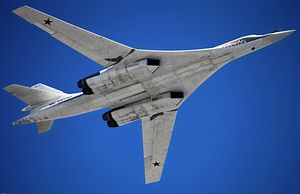Russia’s first upgraded Tupolev Tu-160M2 long-range supersonic strategic bomber purportedly began flight trials last week, a Russian defense industry source revealed on January 24.
“The 804th plane made using Soviet aircraft breakthroughs took to the skies for the first time last week and has been performing evaluation flights since then. The missile-carrying aircraft will be delivered to the Aerospace Force [by] the end of this year,” the source told TASS news agency.
The upgraded Tupolev Tu-160M2 was rolled out at the S.P. Grobunov assembly facility in Kazan, in southwest Russia, on November 16. At the time, Deputy Russian Prime Minister Dmitry Rogozin confirmed that the bomber’s debut flight had been scheduled for February 2018.
“We plan that the aircraft will be built already in 2019. Serial deliveries should begin in 2023 while we plan to carry out the first flight of the Tu-160M2, which has been rolled out of the workshop today, in February next year,” Rogozin said at the time.
While the Russian Aerospace Force has repeatedly stated that the new bomber, aside from the airframe, will be a completely new aircraft, the Russian defense industry source says that the T-160M2 currently conducting flights is not an upgraded prototype.
“The plane underwent only [a] small-scale upgrade while its airframe and the engines have remained the same. Fully digitalized documentation on the new missile-carrying aircraft will be issued no sooner than the middle of this year and the work on building the Tu-160M is impossible without it,” the source said.
This implies that the Russian military aircraft industry still is having trouble with the bomber’s new engine. (Avionics, sensors, displays, communications systems, and operating software will purportedly largely be similar to the Tu-160M variant, the Tu-160M2’s predecessor.) The Tu-160M2 is expected to be fitted with the new Kuznetsov NK-32-2 turbofan engine, providing increased maneuverability and range.
As I noted in November 2017: “The Russian aircraft industry began testing a non-afterburning variant of the Kuznetsov NK-32 engine, purportedly the largest and most powerful turbofan jet engine ever fitted on a bomber, in October.” The new engine will reportedly increase the new bomber’s operational range by up to 1,000 kilometers.
Russian President Vladimir Putin ordered the upgrade of Russia’s Tu-160 force due to delays in the next-generation strategic stealth bomber project, dubbed PAK DA (an acronym for “Prospective Aviation Complex for Long-Range Aviation”) in 2015.
The Russian Aerospace Force plans to induct at least 50 new Tu-160M2s at a rate of three aircraft per year beginning in 2023.
The nuclear-capable bomber is expected to be armed with long-range standoff cruise missiles, including the Kh-101/Kh-102 (nuclear variant) air-launched cruise missile.































